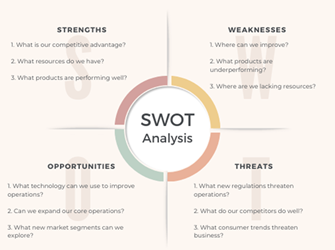Understanding Your Rivals to Gain a Competitive Edge
In today’s dynamic business landscape, staying ahead of the competition is crucial for long-term success. Understanding your rivals is an essential step in this process, providing valuable insights into their strategies, strengths, and weaknesses. By carefully analyzing your competitors, you can identify opportunities to differentiate your offerings, optimize your operations, and ultimately gain a competitive edge.
What is a Competitor Analysis?
Competitive analysis, often known as competitive research, is a branch of strategic research that focuses on gathering and analyzing data on competing companies. It’s a vital strategy for learning what your rivals are up to and what kind of threat they pose to the success of your business. You can use it to find chances to enhance your own company as well.
It’s highly likely that there are other businesses out there providing a comparable good or service to what you provide.
To get an advantage over your rivals in any congested market, you need to know as much as you can.

Why is it important to research competitors?
Competitor analysis can help you:
- Identify your competitors’ strengths and weaknesses.
- Develop a competitive advantage.
- Identify opportunities to improve your own business.
- Stay ahead of the competition.
- Make informed decisions about your business strategy.
Strategic research focused on gathering and analyzing data about competing companies is known as competitive research, or competitive intelligence. It’s a crucial strategy for learning what your rivals are up to and what kind of threat they pose to your business.
How to conduct your competitive analysis
Now that you’ve identified your key competitors, it’s time to dive deeper and unveil their secrets to success. This in-depth competitive analysis will be your roadmap to understanding their strengths, weaknesses, and opportunities, allowing you to develop strategies that set you apart and propel you to the forefront of your market. So, buckle up and get ready to embark on a journey of discovery that will empower you to dominate the competition!
1. Identifying Your Top 5 Competitors
If you are an online seller, you probably face competition from dozens or perhaps hundreds of other businesses vying for the same pool of eligible leads. Regardless of your company’s size—local, national, or worldwide—there is undoubtedly an employee in the sales or marketing departments who can name your top rivals and what sets them apart from you with ease.
Google is a useful tool to help you find your competitors if you need a little assistance. Just Googling for the kind of goods or service you provide will bring up a couple of your main rivals.
Using internet resources like SEMrush is another excellent method to find out who your main rivals are.
Semrush is an excellent tool for seeing how you compare to other businesses and which ones are ranking for the keywords you’re interested in.
2. Compile details about your rivals.
After determining who your rivals are, you must learn more about them. Many resources, including trade publications, industry studies, and the internet, include this information.
3. Examine the advantages and disadvantages of your rivals.
After learning as much as you can about your rivals, you must assess their advantages and disadvantages. This will assist you in finding ways to enhance your own company.
4. Develop a competitive strategy.
Once you have analyzed your competitors’ strengths and weaknesses, you can develop a competitive strategy. This strategy should be based on your own unique strengths and weaknesses.
Perform a SWOT analysis
Consumers are constantly looking for new places to get what they want. Even if they’re loyal to your business, they’re still looking at it in the context of other businesses.
Online competitor analysis allows you to view your business as customers may see it, revealing its strengths and weaknesses as well as the potential opportunities and threats to its existence. This is exactly the information you’ll need to perform your SWOT analysis.

Establish Their SEO Focus
The quality, frequency of publication, and search engine optimization of your competitor’s material all play a role in how effective it is. By examining the following parts of the content samples from Step 3 where keywords are employed, you can do a more qualitative analysis of your competitor’s SEO:
However, there are a number of paid and free tools available that you may use to assess your competitors’ search engine optimization more thoroughly.
Analyze Their Traffic
Say your competitors have the same type of content, update it just as frequently, and produce high-quality work. You might have to look more closely to find what they are doing differently. It might be their SEO, if your company has a blog, you know how important your SEO is. Take into account the SEO of the content you are producing while performing a competitive analysis of the kind of material
Conduct a comprehensive analysis of your competitors’ marketing strategies, identifying areas where their messaging or branding is weak. Your team’s marketing expertise can then be used to craft a more compelling and effective strategy that captures the attention of your target audience.
Analyzing Your Competitors’ Strategies
Marketing:
- How are your competitors marketing their products or services?
- What are their target markets?
- What is their messaging?
Sales:
- How are your competitors selling their products or services?
- What are their sales channels?
- What is their pricing strategy?
Product Development:
- What are your competitors’ product development strategies?
- What new products or services are they developing?
- How are they responding to customer feedback?
Compare them to one another
It is helpful to compare competitors with each other as well as with your business. Even though these businesses may be fighting for your business, that doesn’t imply that’s how they do things. After gathering information on these companies, create thorough profiles that let you assess their level of hazard and how they do business.
A side-by-side comparison is the simplest approach to accomplish this. Add any information that would help one company stand out from the others, such as the products and services they provide, business categories, locations, target customers, distribution routes, and special abilities. Set aside one area to compose a company profile.

Identify areas for improvement
You now have a clearer picture of what your rivals are up to after conducting a competitive analysis.
Utilizing the data you have collected about each rival, pinpoint specific aspects of your own work that want improvement. You are sure to find something if you search well enough.
You’ll be able to pinpoint important areas for improvement, particularly with relation to the messaging you convey to prospective clients, blog readers and subscribers, and social network users.
Conclusion
Key takeaways:
- Competitor analysis is a crucial step in any business strategy.
- There are several different methods for conducting competitor analysis.
- The most important thing is to gather and analyze as much information as possible about your competitors.
- By understanding your competitors, you can develop strategies to gain a competitive advantage.


